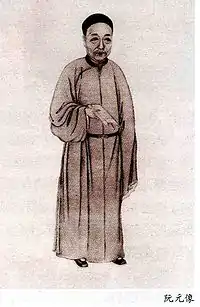Ruan Yuan 阮元 | |
|---|---|
 | |
| Viceroy of Huguang | |
| In office 1816–1817 | |
| Preceded by | Sun Yuting |
| Succeeded by | Qingbao |
| Viceroy of Liangguang | |
| In office 22 October 1817 – 22 June 1826 | |
| Preceded by | Jiang Youxian |
| Succeeded by | Li Hongbin |
| Viceroy of Yun-Gui | |
| In office 1826–1835 | |
| Preceded by | Zhao Shenzhen |
| Succeeded by | Yilibu |
| Personal details | |
| Born | February 21, 1764 Yizheng, Qing Dynasty |
| Died | November 27, 1849 (aged 85) Yangzhou, Qing Dynasty |
| Occupation | Historian, politician, writer |
| Ruan Yuan | |||||||||||||||||||||||||
|---|---|---|---|---|---|---|---|---|---|---|---|---|---|---|---|---|---|---|---|---|---|---|---|---|---|
| Chinese | 阮元 | ||||||||||||||||||||||||
| |||||||||||||||||||||||||
Ruan Yuan (Chinese: 阮元; 1764–1849), courtesy name Yuntai (云台), was a Chinese historian, politician, and writer of the Qing Dynasty who was the most prominent Chinese scholar during the first half of the 19th century.[1] He won the jinshi degree in the imperial examinations in 1789 and was subsequently appointed to the Hanlin Academy. He was known for his work Biographies of Astronomers and Mathematicians and for his editing the Shisan Jing Zhushu (Commentaries and Notes on the Thirteen Classics) for the Qing emperor.
Ruan Yuan was a successful official as well as a scholar. He was the Viceroy of Liangguang, the most important imperial official in Canton (Guangzhou), during the critical years 1817–1826, just before the First Opium War with Britain. It was a crucial time when Chinese trade with the outside world was allowed only through the Canton System, with all foreigners confined to Canton, the capital of Guangdong Province. During his tenure in Canton, Ruan is estimated to have earned more than 195,000 taels of silver.[2]
He was widely recognized as an official, scholar, and patron of learning both by his contemporaries and by modern scholars. He was also praised as an honest official and an exemplary man of the ‘Confucian persuasion’. His name is mentioned in almost all works on Qing history or Chinese classics because of the wide range of his research and publications. A number of these publications are still reprinted. Ruan Yuan was a follower of the Han Learning tradition and as such, with the encouragement of Liu Fenglu, he edited and organized publication of the compendium of the imperial achievements in kaozheng scholarship, the Huang Qing Jingjie (皇清经解) published in 1829.
Kong Luhua (relative of the Duke Yansheng) was the second wife of Ruan Yuan.[3]
References
- ↑ Shaughnessy (1991), p. 12.
- ↑ Wei 2006, p. 301.
- ↑ Betty Peh-T'I Wei (1 August 2006). Ruan Yuan, 1764-1849: The Life and Work of a Major Scholar-Official in Nineteenth-Century China before the Opium War. Hong Kong University Press. pp. 246–. ISBN 978-962-209-785-8.
- Bibliography
- Hummel, Arthur W. Sr., ed. (1943). . Eminent Chinese of the Ch'ing Period. United States Government Printing Office.
- Miles, Steven B. (2006). "Establishing authority through scholarship: Ruan Yuan and the Xuehaitang Academy". In Hershock, Peter D.; Ames, Roger T. (eds.). Confucian Cultures of Authority. SUNY Press. pp. 151–169. ISBN 978-0-7914-8156-1.
- Miles, Steven B. (2006). The Sea of Learning: Mobility and Identity in Nineteenth-Century Guangzhou. Harvard University Press. ISBN 978-0-674-02134-1.
- Shaughnessy, Edward L. (1991). Sources of Western Zhou History: Inscribed Bronze Vessels. University of California Press. ISBN 9780520070288.
- Wei, Betty Peh-T'i (2006). Ruan Yuan, 1764–1849: The Life And Work of a Major Scholar-Official in Nineteenth-Century China Before the Opium War. Hong Kong University Press. ISBN 962-209-785-5.
External links